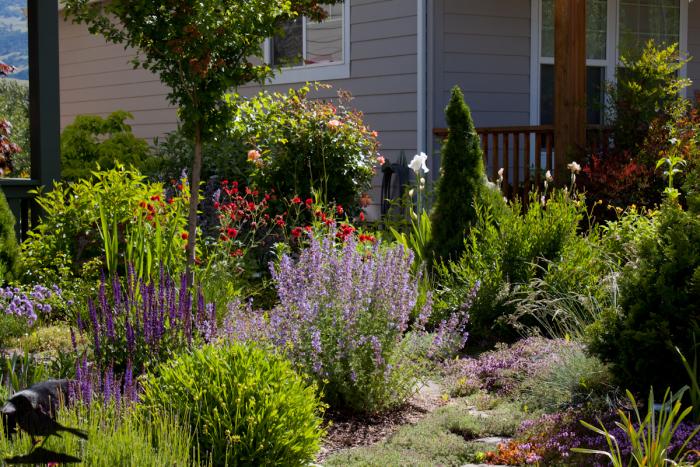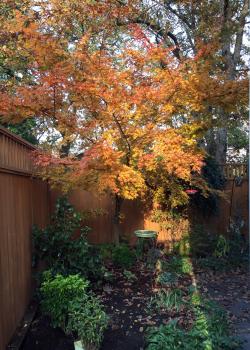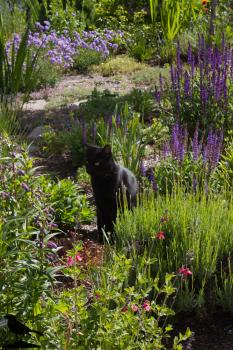Professional Native Landscape Design
Blog Post
Watering Guidelines for the Rogue Valley
posted: August 13th, 2023
*Note:The following has been excerpted from the Watering Guidelines provided by the professionals at Shooting Star nursery. Landscaping and soil conditions vary based on site conditions. Neither Shooting Star nor Rockbird Gardens is liable for any watering mishaps.
The following assumes many factors:
- Lawns should always be on their own watering schedule zone.
- You have done your soil prep and know how well your soil drains.
- You have chosen the "right plant for the right place" and have grouped together plants for the best use of your irrigation system watering zones.
- You have planted properly, making sure the pots are well watered before planting and the plants are "watered in" using a garden hose.
Irrigation Schedules:
What may be good for lawns is not good for trees, shrubs or perennials. Frequent, shallow watering only encourages shallow root systems.
Even if it is 100 degrees out, do not water twice a day or even every day. The plants cant take up that much water because they shut down in extreme heat. Most water-wise garden plants need a period to dry out between watering sessions.
Make sure the plant has been well watered before it is planted and the surrounding soil has been watered so that the plant isn't going into a dry hole. Water deeply right after planting. Often, a dam around the new plantings helps keep the water in place and filtering down to the root zone.
- Most drought-tolerant plants (think: butterfly plants), on average, need deep watering every 2-3 days for the first 2-4 weeks after planting. After that, they can be watered every 3-4 days. After the first year once a week can often be enough.
- In our heavy clay soils,or if the weather is cooler (think Spring and Fall) the same plants will need water less often.
- Make sure your system is set with watering times that are long enough - at least an hour for a deep soak. Sometimes multiple start times will ensure water reaches the important "root zone".
- Most perennials and drought tolerant shrubs are fine with a 1 gallon per hour drippers. The larger root zones on a drought tolerant shrub might be fitted with 2 emitters of 1/2 GPH.
- Larger shrubs can use 2 drippers on either side of at least 1-2 GPH for each side to insure deep watering.
- 4 inch plants will need supplemental hand watering to get them off to a good start in hotter weather. You do not want to increase watering times just to cover the 4" plants as it risks overwatering the larger plants in the same zone.
- For non drought-tolerant plants, (ex: rhodies, ferns, dogwood shrubs) on average, water deeply every 2-3 days for the first 2-4 weeks after planting. After that, they can be watered every 3-4 days. After a year, twice a week can be enough as long they gets deep soaking.
- Trees need watering with multiple drippers around the root zone. Be sure and move the drippers out from the trunk as the tree matures. Tree roots extend far beyond the canopy.
- Long, deep soaking is needed to encourage tree roots to grow deep down to reach water themselves.
- Trees need a good, deep soaking upon planting and then on average a deep soak for an hour or 2 once a week through the first summer.
- Once established, many trees need a deep, long soak every two weeks, especially fruit trees, which do poorly with "wet feet".
- Most trees do not like being watered daily and ideally should be placed on a different zone and watering schedule than shrubs and perennials.
After Planting
- Observe the plants in the garden during the first week to see if the schedule that has been set is making sense for the site and the plants are thriving. (A bit of transplant shock is normal).
- Check the soil moisture at least 6 inches under the mulch to determine if the soil is staying too moist (it should dry out between watering)
- Check the soil moisture the day before the irrigation is set to run to make sure the plants need water and adjust watering frequency accordingly.
- Check the irrigation schedule after a month to see if it needs adjusting and dial back watering frequency once plants have begun to get established.
- Make sure you are not over watering during heat spells. Plants often take up LESS water during heat spells because they shut down normal processes. If you water too much, you are in danger of drowning them.




